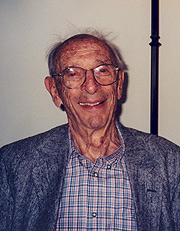Berkeleyan
Obituary
Heinz Heinemann
![]()
12 January 2006
 Heinz Heinemann |
Heinz Heinemann, a longtime lecturer in the College of Chemistry and a chemistry researcher at Lawrence Berkeley National Laboratory (LBNL), died Nov. 23 of pneumonia. He was 92.
During a 60-year career in industry and academia, Heinemann contributed to the invention and development of 14 commercial fossil-fuel processes, received 75 patents, and was the author of more than 150 publications. Among his inventions was a process for converting methanol to gasoline.
At his death, he was a distinguished scientist in the Washington office of LBNL. Between 2001 and 2004 he served as a manager of the Chemical Society of Washington, a local section of the American Chemical Society, and as president of the organization's Retired Chemists Group.
Born in Berlin, Germany, in 1913, he attended the University and Technische Hochschule in Berlin. When his doctoral dissertation was rejected because he was Jewish, he made his way to Basel, Switzerland, where he received his Ph.D. in physical chemistry from the University of Basel before coming to the United States in 1938. He became a U.S. citizen in 1944.
Heinemann worked for several petroleum companies in Louisiana and Texas and won a postdoctoral fellowship at the then-Carnegie Institute of Technology, now Carnegie-Mellon University. The fellowship, funded by the government of the Dominican Republic, involved research into ethanol, which was made from the Dominican Republic's primary cash crop, sugar cane.
Heinemann published the majority of his papers and received most of his patents in the field of catalysis and petroleum chemistry. During his 40 years with industry, he actively participated in the research and development of 14 commercial processes, including the process for converting methanol to gasoline.
After retiring from industry in 1978, he joined LBNL as a researcher and became a lecturer in the Department of Chemical Engineering. His research involved coal gasification, catalytic coal liquefaction, hydrodenitrification, nitrogen-oxide emission control, and the development of a special catalyst that enables methane, the major component of natural gas, to be used to make petrochemicals. The research team he led invented and patented a process known as catalytic oxydehydrogenation.
He received many honors, among them election to the National Academy of Engineering, the Houdry Award of the Catalysis Society, the Murphree Award of the American Chemical Society, the H. H. Lowry Award (presented for research he pursued in his 70s), and a Distinguished Scientist/Engineer award from the U.S. Department of Energy.
He is survived by his wife of 10 years, Dr. Barbara Tenenbaum of Washington, D.C.; daughter, Sue Heinemann of Oakland, Calif.; and son, Peter Heinemann of San Francisco. His first wife, Elaine Heinemann, died in 1993 after 46 years of marriage.
Contributions may be made in his memory to the Heinz Heinemann Memorial Fund. Donations should be made payable to the UC Berkeley Foundation and sent to the attention of Jane Scheiber, College of Chemistry, 420 Latimer Hall #1460, University of California, Berkeley, CA 94720-1460.
- Robert Sanders

